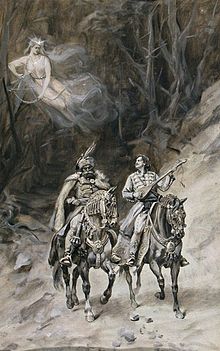
Back Wila Afrikaans ভিলা (পরী) Bengali/Bangla Víla Czech Wiła CSB Wila (Mythologie) German Willi Spanish Wili French ויליה HE Vilák Hungarian Վիլա (դիցաբանական կերպար) Armenian
This article needs additional citations for verification. (May 2021) |

A vila, or víla [ˈviːla] (plural: vile, or víly [ˈviːli]; Bulgarian: vila, diva, juda, samovila, samodiva, samojuda; Czech: víla, samodiva, divoženka; Old East Slavic: vila; Polish: wiła; Serbo-Croatian: vila; Slovak: víla; Slovene: vila)[1] is a Slavic fairy similar to a nymph.
The vila is mostly known among South Slavs; however, some variants are present in the mythology of West Slavs as well. Among Czechs, víla denotes a woodland spirit (15th century), and ancient place names such as Vilice near Tábor, Vilov near Domažlice, and Vilín near Sedlčany seem to indicate that she was known there as well.[2] In the Chronicle of Dalimil (3, 53) vila is "fool" (as in Old Polish). In Russia, vile are mentioned in the 11th century, but there is doubt that they were truly a part of Russian folklore, and not just a literary tradition. There are common traits between the vile and the rusalki, and Schneeweis holds that they are identical.